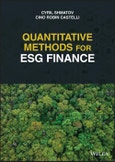In Quantitative Methods for ESG Finance, accomplished risk and ESG experts Dr. Cyril Shmatov and Cino Robin Castelli deliver an incisive and essential introduction to the quantitative basis of ESG finance from a quantitative analyst’s perspective. The book combines the theoretical and mathematical bases underlying risk factor investing and risk management with accessible discussions of ESG applications.
The authors explore the increasing availability of non-traditional data sources for quantitative analysts and describe the quantitative/statistical techniques they’ll need to make practical use of these data. The book also offers: - A particular emphasis on climate change and climate risks, both due to its increasing general importance and accelerating regulatory change in the space - Practical code examples in a Python Jupyter notebook that use publicly available data to demonstrate the techniques discussed in the book - Expansive discussions of risk factor investing, portfolio construction, ESG scoring, new ESG-driven financial products, and new financial risk management applications, particularly those making use of the proliferation of “alternative data”, both text and images
A must-read guide for quantitative analysts, investment managers, financial risk managers, investment bankers, and other finance professionals with an interest in ESG-driven investing, Quantitative Methods for ESG Finance will also earn a place on the bookshelves of graduate students of business and finance.
Table of Contents
Foreword vii
Introduction and Book Overview 1
1. Overview 1
2. Why ESG Finance? 2
3. Why Quantitative Methods? 2
4. Target Audience and Timing of This Book 2
5. Book Outline 3
1 Introduction to ESG Finance 5
1.1 Preface: ESG Is Not a Niche Strategy Anymore 5
1.2 Introduction and Definitions 7
1.3 ESG Investment Performance 21
1.4 Sustainability and Sustainable Finance 25
2 Factor Investing and Smart Beta 39
2.1 Index Construction Basics 39
2.2 Smart Beta Indexes 40
2.3 Risk Factor Investing 48
2.4 Fama- MacBeth Regressions 50
2.5 Expanding the Risk Factor Universe 53
3 ESG Ratings 55
3.1 Introduction 55
3.2 Overview of ESG Rating Methodologies 57
3.3 Regression Trees as an Alternative Scoring Technique 61
3.4 Random Forest 69
4 Alternative Data 75
4.1 What Are Alternative Data and Their ESG Applications? 75
4.2 How to Validate an ESG Data Provider 81
4.3 Processing Satellite Data 83
5 Alternative Text Data 105
5.1 Alternative Text Data on ESG 105
5.2 Corporate ESG Reports 108
5.3 Topic Modeling 114
5.4 Latent Dirichlet Allocation 118
5.5 Outlier Topics 126
6 Introduction to Agent- Based Modeling for ESG Finance 129
6.1 Preface 129
6.2 Use of Agent- Based Models in Other Fields and Their Applicability to ESG Finance 131
6.3 Use of ABMs in the ESG Field 132
6.4 General Overview of ABMs 133
6.5 General Operating Principles of ABMs 136
6.6 Example of the PartE Framework Applied to an ESG Scenario 136
6.7 Why We Should Look Closely at ABMs 138
6.8 Challenges in the Use of ABMs 139
6.9 Example: Buildup of a Population Model ABM 140
6.10 In- Depth Review: ABMs in Academic and Regulatory Publications 154
7 Climate Risk: Macro Perspective 165
7.1 Climate Change: Background Information and Definitions 165
7.2 Regulatory Response to Climate Change 185
7.3 Climate Change Modeling 191
7.4 Carbon Risk and Carbon Pricing 199
7.5 Climate Risk in Investment Practice 202
8 Stress Testing for Banks 207
8.1 Stress Testing as a Risk Management Tool 207
8.2 Macroeconomic Stress Scenarios for Climate Risk 213
8.3 Climate Loss Modeling 220
8.4 Climate Stress Testing Exercise 223
8.5 Concluding Notes 224
Index 227








